2017 Ford C-Max Hybrid
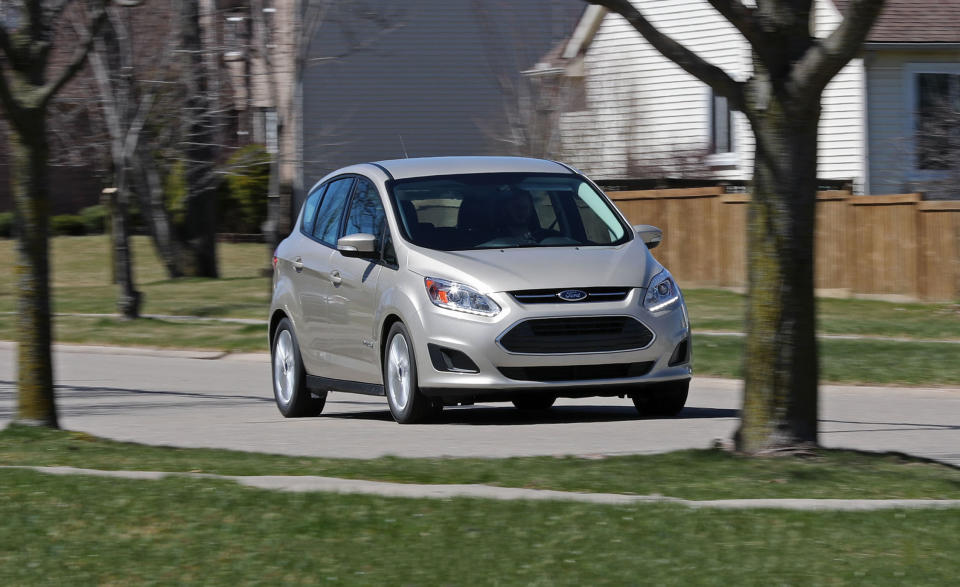
Currency in the world of dedicated hybrids—so, gas-electric vehicles sold without a non-electrified equivalent—is measured in mpg. Despite today’s low gasoline prices, this efficiency figure matters more than ever as a marketing beacon to actually move such metal. After all, why pay extra for a fuel-sipping hybrid if it isn’t mind-blowingly efficient compared to a regular, gas-powered car of similar size? Subjected to this reality, the Ford C-Max’s appeal fades.
Although the C-Max is refreshed alongside its plug-in-hybrid counterpart for 2017 with slightly sharper headlights and taillights, its mechanicals are the same as they’ve been since 2013. That means the Ford’s fuel economy is, by and large, the same as it’s always been. (The EPA estimates have been adjusted a bit, lowered for 2014 before inching up by 1 mpg in the city and 2 mpg on the highway, to 42 mpg city and 38 mpg highway this year.) We recorded 35 mpg over the course of this test, and a less-encouraging 33 mpg on our 200-mile highway fuel-economy test loop. That average fuel-economy number is better than that of the last C-Max we tested, a 2013 model that scored 32 mpg, yet still middling enough to raise the “why buy?” question.
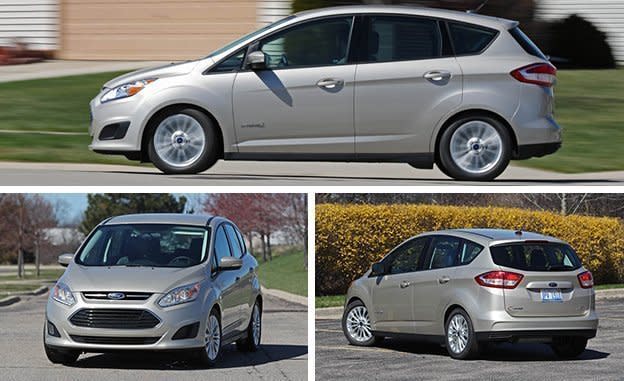
Specifically, the “why” applies to the C-Max’s relative frumpiness and sloth compared to more conventional compact cars that match or better its fuel-economy performance. Our long-term Honda Civic test car, for example, uses a turbocharged four-cylinder engine and scored 41 mpg on the same highway test loop. The Honda also handles well, doesn’t stand out as much, and can reach 60 mph in 6.9 seconds, a full second quicker than this Ford. It doesn’t help that the C-Max’s cabin looks quite dated, especially with the tiny dashboard display standard on the SE model tested here (the uplevel Titanium swaps in a snazzier touchscreen) and plenty of hard plastics.
Yesterday’s Performance, Today
The goalposts for hybrids have moved since Ford introduced the C-Max in 2012. Other hybrids have been achieving ever-higher mpg numbers. The Hyundai Ioniq, for example, is a sleeker tadpole-shaped dedicated hybrid that is EPA-rated for up to 58 mpg. (Hyundai even offers plug-in and full-EV Ioniqs that are still more miserly.) Toyota’s latest Prius, ever the bogey in this segment, also is capable of 58 mpg on the EPA’s city test cycle; we’ve measured an average of 47 mpg in a Prius Eco, while the least-efficient current-generation Prius we tested posted 42 mpg overall. The new Kia Niro, whose tall hatchback body most closely matches the bulbous C-Max’s shadow, notched 37 mpg combined in our test.
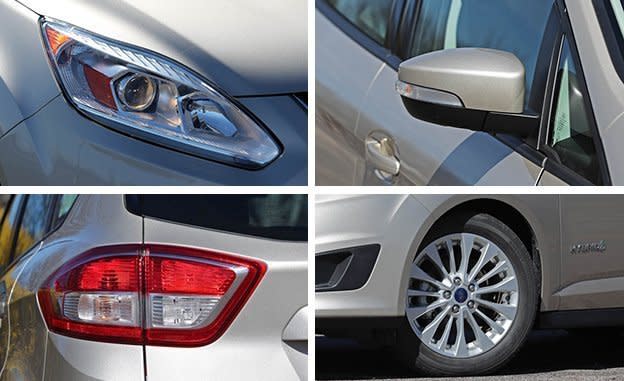
We’d go so far as to claim that even the Toyota’s 47 mpg, while amazing (particularly given how we don’t drive cars gingerly at Car and Driver), isn’t enough to make an economic argument for a hybrid right now. A Volkswagen Golf, for example, is a roughly 30-mpg hatchback with nearly the same interior and cargo space as either the C-Max or a Prius, yet it costs less and drives conventionally, without the weird power surges or lag from complex mixtures of electric and internal-combustion power sources. If you’re absolutely dead-set on a hybrid and the economics are secondary, though, there’s no ignoring the 10-mpg-plus advantage that newer hybrids hold over the C-Max.
Not So Very Weird
The Ford continues to distinguish itself by delivering what is among the most normalized hybrid driving experiences. Other than spongy brake feel (common to hybrids blending regenerative braking, which converts motion to electricity, with mechanical braking) and an occasionally growly engine sound, the C-Max faithfully mimics a tall, ordinary hatchback.
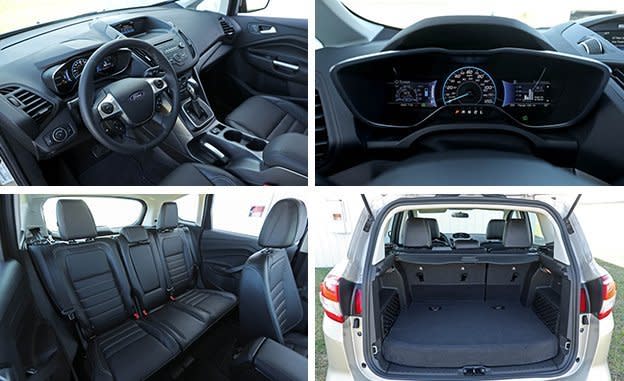
None of Ford’s changes for 2017 should have affected the car’s performance, yet this test car shaved nearly a second from the zero-to-60 mph time recorded by a 2013 model we tested, and it stopped eight feet shorter from 70 mph using the same engine, electric motor, battery, and even the same size and brand of tire. Of greater value is the powertrain’s responsiveness and lack of sluggishness relative to a Prius’s and its fine-riding suspension that keeps a tight reign over body motions through turns and over pockmarked pavement.
This praise only brings us back to the “why buy” query, however. The C-Max might feel normal, and its tall body offers a modicum of practicality with a full 25 cubic feet of trunk space behind the second-row seats, but so, too, do everyday compact hatchbacks. The Chevrolet Cruze, Honda Civic, Mazda 3, VW Golf all are more satisfying to drive, more enjoyable to look at, nearly as efficient, far newer designs, and cost thousands of dollars less.
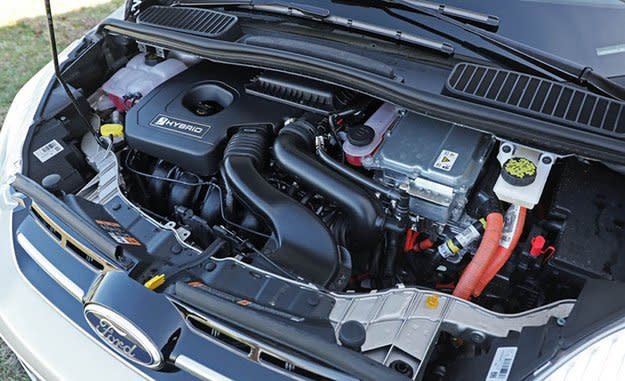
The flesh-colored C-Max we tested started at $25,050, while a $1600 package with heated leather seats, a 10-way power driver’s seat, and heated door mirrors with puddle lamps brought the total to $26,650. On paper, it is thoroughly out-hybrided by the similarly priced Prius and Ioniq, while Kia’s similar Niro can be had for just $23,785 and has a more comfortable back seat, fresher in-car tech options, and similar pseudo-crossover cred. Come to think of it, the Ford’s so-so fuel economy might not be its biggest problem. Its own age and the freshness of its competition loom larger.
Specifications >
VEHICLE TYPE: front-engine, front-motor, front-wheel-drive, 5-passenger, 4-door hatchback
PRICE AS TESTED: $26,650 (base price: $25,050)
ENGINE TYPE: DOHC 16-valve Atkinson-cycle 2.0-liter inline-4, 141 hp, 129 lb-ft; permanent-magnet synchronous AC motor, 118 hp, 117 lb-ft; combined output, 188 hp; 1.4-kWh lithium-ion battery pack
TRANSMISSION: continuously variable automatic
DIMENSIONS:
Wheelbase: 104.3 in
Length: 173.6 in
Width: 72.0 in Height: 63.8 in
Passenger volume: 100 cu ft
Cargo volume: 25 cu ft
Curb weight: 3630 lb
C/D TEST RESULTS:
Zero to 60 mph: 7.9 sec
Zero to 100 mph: 20.6 sec
Zero to 110 mph: 26.8 sec
Rolling start, 5–60 mph: 8.2 sec
Top gear, 30–50 mph: 3.8 sec
Top gear, 50–70 mph: 5.2 sec
Standing ¼-mile: 16.1 sec @ 89 mph
Top speed (governor limited): 117 mph
Braking, 70–0 mph: 183 ft
Roadholding, 300-ft-dia skidpad*: 0.78 g
FUEL ECONOMY:
EPA combined/city/highway: 40/42/38 mpg
C/D observed: 35 mpg
C/D observed 75-mph highway driving: 33 mpg
C/D highway range: 440 mi
*stability-control-inhibited

 Yahoo Autos
Yahoo Autos 